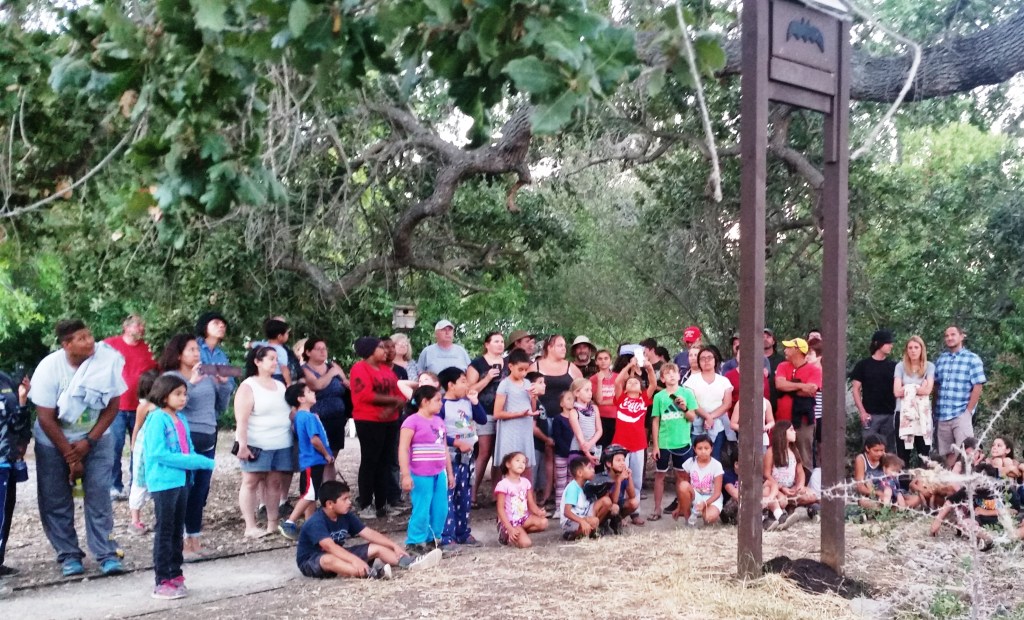Press releases are posted on Independent.com as a free community service.
Going Batty the Neal Taylor Nature Center – August 2022

Come to the Nature Center and take in our Live Bat program & exhibit – Going “Batty” at the Nature Center – a Living Bat exhibit of MYOTIS CALIFORNICUS BATS. Meet behind the Nature Center for a guided talk of our living exhibit of the local bats and watch them come out to feed. A Nature Center Host will make this presentation
For More Info: Call (805) 693-0691or e-mail Julie@clnaturecenter.org
History of Bat Box and Resident Bats at the Nature Center
The Bat Box (about 3 feet by 1 ½ feet) was designed, built, and erected in October 2013 by Nature Center volunteer Michael Marlow. It is suspended between two poles 16 feet off the ground. It is located behind the garage of the Nature Center in the Nature Center’s Native Garden. Michael built a second Bat “Condo” 5 years later to accommodate our expanding bat population. This 2nd bat box can be viewed at the Southeast end of the Nature Center’s Native Garden.
Guano under the Bat Box accumulated over time, and it is important to not go near the guano.
Two NC Volunteers on 9/28/15 counted 272 bats fly out of the box at dusk. These same Volunteers on 5/10/16 counted 238 bats fly out at dusk. The bat population since then has continued to expand.
Paul Collins biologist with the Santa Barbara Natural History Museum has completed a two-year research project on bats. Paul identified these bats as Myotis Californicus Bats which are considered micro bats.
Characteristics of Myotis Californicus Bats
Size
Body length: 1.5-2 inches (70-94mm)
Weight: 0.1 ounce
Wingspan: 6-9 inches from tip to tip
Females are slightly larger than males
Description
Small, mouse eared bats.
Have small feet.
Fur is pale brown, sometimes with a yellow cast.

Location
Deserts and arid basins.
Found from British Columbia, through the west coast of the United States, Mexico, and Guatemala.
Found in caves, mines, rocky hillsides, under tree bark and shrubs.
May migrate in winter.
Roost alone or in small groups in warmer months.
Females
Bats are mammals. They birth live young
Birth one pup a year, usually in May or June.
Pups feed on mother’s milk for several weeks.
Feeding
Nocturnal
Stays in canopy of trees eating mosquitoes and other insects and moths
Must eat about 1/3-1/2 its weight.
Life Span
Live for 20-30 years
Social calls
Can be heard inside the Bat Box.
Calls outside the Bat Box are above our ability to hear.
Sense of hearing
Bats rely on an echo of sound transmitted back to them called echo location.
This is a perceptual system where ultrasonic sounds are emitted by the bat specifically to produce echoes.
The delay of the returning echoes gives the bat the ability to estimate the range of their prey. Microbats use echo location for navigation and finding prey.
- Sat. Aug. 6th (7:55 PM)
- Sat. Aug. 13th (7:45 PM)
- Sat. Aug. 20th (7:35 PM)
- Sat. Aug. 27th (7:25 PM)
- Meet at designated time in front of the Nature Center
- Living exhibit –watch local bats come to feed!
- Close to 300 bats each in 2 bat boxes as part of exhibit!
- Guided program – by Nature Center
- Admission: Donations appreciated
For more information Call 805-693-0691 or Julie@clnaturecenter.org



You must be logged in to post a comment.